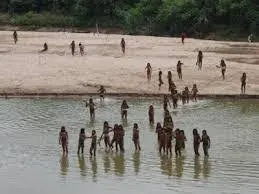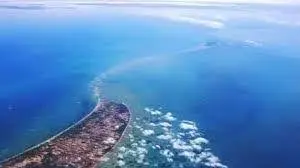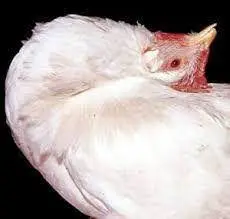UPSC GS 1
Bhil Tribe
- News: A large number of people from the Bhil tribe are demanding an independent ‘Bhil state’. “
- Definition: Bhils are considered one of the oldest tribes in India, known for their distinct cultural and historical significance.
- Etymology: The name ‘Bhil’ is derived from the word villu or billu, which means bow in the Dravidian language.
- Racial Identification: Bhils are identified as one of the Dravidian racial tribes of Western India.
- Ethnic Group: They belong to the Australoid group of tribes.
- Central Bhils: Found in the mountain regions of Madhya Pradesh, Maharashtra, Gujarat, and Rajasthan.
- Eastern or Rajput Bhils: Found in the northeastern parts of Tripura.
- Primary Language: Bhils speak Bhili, an Indo-Aryan language.
- Local Deities: The Bhils worship various local deities such as Khandoba, Kanhoba, Bahiroba, and Sitalmata.
- Tiger God: Some Bhils worship a Tiger God called ‘Vaghdev’.
- Consultation of Sorcerers: They consult Badvas, hereditary sorcerers, on various occasions.
- Main Festival: The Baneshwar fair is the main festival celebrated among the Bhils.
- Significance: This fair is held during Shivratri and is dedicated to Baneshwar Mahadev, also known as Lord Shiva.
Mashco Piro Tribe
- News: Rare photos have captured the Mashco Piro, a previously uncontacted tribe deep in the Peruvian Amazon, emerging from their isolated territory.

- Population and Location:
-
- The Mashco Piro are believed to be the largest uncontacted tribe on Earth, numbering more than 750 people.
- They inhabit the Amazon jungles of the Madre de Dios Region, near Peru’s border with Brazil and Bolivia.
-
- Historical Background:
-
- The tribe is thought to have retreated deeper into the jungle during the Amazon Rubber Boom in the late 1800s, a period marked by exploitation and violence against many indigenous tribes.
-
- Habitat:
-
- They live along the banks of the Las Piedras River within the Alto Purús National Park.
- Their homes are made of palm leaves, with huts in the rainforest used during the rainy season.
-
- Language: The Mashco Piro speak a dialect of the Piro language.
- Way of Life:
-
- Clothing: Tribe members wear minimal clothing. Typically, they don a yellowish-brown cloth above the waist and may use arm and leg bands of the same color.
- Appearance: They have medium stature, athletic builds, and straight black hair worn shoulder-length or longer.
- Hunting: Men are likely hunters, using bows and arrows, as well as spears, which they have been observed carrying.
-
- Government Protection: The Peruvian government has prohibited contact with the Mashco Piro to prevent the potential spread of diseases to which the tribe has no immunity.
See more: Foundation Course For IAS/IPS/UPSC: The Ultimate Guide
Adam’s Bridge
- News: Using data from a US satellite, Indian space scientists have come out with the most detailed map of the Adam’s Bridge – more popular as Ram Setu.
- Overview:
-
- Adam’s Bridge, also known as Ram Sethu Bridge, connects Rameswaram Island off the southeast coast of India to Mannar Island off the northwest coast of Sri Lanka.
- It separates the Gulf of Mannar (to the southwest) from the Palk Strait (to the northeast).
-
- Geological Features:
-
- Structure: The bridge is a 48 km long chain of natural limestone shoals.
- Navigation: Some sandbanks are dry, and the sea in the area is very shallow, ranging from 1 to 10 meters deep in places, which impedes navigation.
-

- Historical and Mythological Significance:
-
- Geologic Evidence: Suggests that Adam’s Bridge represents a former land connection between India and Sri Lanka.
- Ramayana: Mentioned in the epic Ramayana as the bridge constructed by Lord Rama and his vanara (monkey) army to cross over to Lanka and rescue Goddess Sita from the demon king Ravana. In Valmiki’s Ramayana, the bridge is referred to as Sethubanthan.
- Islamic Legend: According to Islamic legend, Adam used this bridge to reach Adam’s Peak in Sri Lanka.
-
- Historical Records:
-
- Rameshwaram Temple: Records indicate that Adam’s Bridge was completely above sea level until 1480, after which it was submerged due to natural calamities.
-
UPSC GS 2
Economic Survey
- News: Union Finance Minister Nirmala Sitharaman will be tabling the Economic Survey 2024-25 on July 22, the first day of the monsoon session of Parliament.
- Definition: The Economic Survey is a document that offers a thorough examination of India’s economic performance in the previous fiscal year, encompassing sectors like agriculture, industry, and services.
- Data Compilation: It includes extensive statistical information on economic indicators such as GDP growth, inflation, employment rates, fiscal deficit, and other relevant metrics.
- Who makes the Economic Survey?
-
- It is crafted by the Economic Division of the Department of Economic Affairs within the Union finance ministry, overseen by the Chief Economic Advisor.
- The completed document undergoes scrutiny by the Finance Secretary and receives final approval from the Finance Minister of India.
-
- When and who presents the Economic Survey?
-
- It is presented every year in Parliament during the Budget Session.
- It is presented normally a day before the presentation of the Union Budget in the Parliament by the Finance Minister of India.
-
- History:
-
- The first economic survey came into existence in 1950-51 as part of the budget documents.
- It was later separated from the Budget documents in the 1960s and presented the day before the Union Budget.
-
- What do the Economic Survey documents contain?
-
- The Survey has two parts–one, one consists of the economic challenges that the country is facing and the second is the review of the year gone by.
-
- Is it binding on the government to present the Economic Survey?
-
- No. It is nowhere mentioned in the Constitution.
- However, it is now part of the Government Practice to present the Economic Survey every year before the budget.
-
Bhusanket Web Portal
- News: Recently, the Union Minister of Coal and Mines inaugurated the National Landslide Forecasting Centre at the Geological Survey of India (GSI) in Kolkata. Additionally, the Bhusanket Web Portal and Bhooskhalan Mobile App were launched.
- About Bhusanket Web Portal:
- Functionality: The Bhusanket Web Portal is designed to facilitate the dissemination of relevant data and information on landslide hazards.
- Forecasting: It initiates short-range and medium-range landslide forecasting in the country.
- Integration: The portal is integrated with the user-friendly Bhooskhalan Mobile App.
- About Bhooskhalan Mobile App:
- Purpose: The Bhooskhalan Mobile App enables quick dissemination of daily landslide forecasts.
- User Interaction: It allows stakeholders to share and update spatial and temporal information on landslide occurrences.
- Availability: The app is available on the Bhusanket Web Portal and will soon be available on Google Play Store.
- Key Facts about Geological Survey of India (GSI):
- Establishment: GSI was set up in 1851, primarily to find coal deposits for the Railways.
- Affiliation: It is an attached office to the Ministry of Mines.
- Primary Functions:
-
- Creating and updating national geoscientific information.
- Mineral resource assessment.
-
- Methods:
-
- Ground surveys, air-borne and marine surveys.
- Mineral prospecting and investigations.
- Multi-disciplinary geoscientific, geo-technical, geo-environmental and natural hazards studies.
- Glaciology and seismo-tectonic studies.
- Conducting fundamental research.
-
- Documentation: Systematic documentation of all geological processes, both surface and subsurface, of the country and its offshore areas.
- Repository Role: Functions as a ‘Repository’ for geological information.
- Technology Use: Utilizes the latest computer-based technologies for the dissemination of geoscientific information and spatial data.
- Collaboration: Engages in cooperation and collaboration with other stakeholders in the Geo-informatics sector.
- Headquarters: Kolkata
- Regional Offices: Located in Lucknow, Jaipur, Nagpur, Hyderabad, and Shillong.
UPSC GS 3
Cadmium Telluride (CdTe)
- News: According to a study by researchers at the Indian Institute of Technology (IIT), Mandi in Himachal Pradesh, CdTe (Cadmium telluride) technology exhibits some of the least environmental impact among solar cell technologies in India.
- Composition: Cadmium Telluride (CdTe) is a material made from the combination of two elements: Cadmium (Cd) and Tellurium (Te).
- Physical Description: It is an odorless and black crystalline solid.
- Properties of Cadmium Telluride
-
- Solubility: Insoluble in water but dissolves in nitrate acid.
- Oxidation: Undergoes oxidation in moist air with long-time exposure.
-
- Environmental Impact:
-
- Lowest carbon dioxide emissions.
- Minimal ozone depletion potential.
- Reduced human health effects.
- Low particulate air pollution.
-
- Applications of Cadmium Telluride:
-
- Room Temperature Semiconductor Detector: Suitable for applications such as an infrared optical window and lens.
- Thin Film Solar Cell Material: Widely used in thin film solar cells.
-
- Photovoltaic (PV) Technology : CdTe is the second most common photovoltaic (PV) technology in the world, after silicon.
- IIT Mandi Study
- Objective: Conducted a life-cycle assessment (LCA) to identify the most sustainable options for solar energy production in India.
- Solar Cell Technologies Assessed:
-
- Cadmium Telluride (CdTe)
- Mono-silicon
- Polysilicon
- Copper Indium Gallium Selenide (CIGS)
- Passivated Emitter & Rear Contact (PERC)
-
Pralay Missile
- News: India has successfully test-fired its surface-to-surface short-range ballistic missile (SRBM) ‘Pralay’.
- Type: The Pralay is a 350-500 km short-range, quasi-ballistic surface-to-surface missile.
- Payload Capacity: It can carry a payload of 500-1,000 kg.
- Development: It is based on the Prithvi Defence Vehicle and has been developed by the Defence Research and Development Organisation (DRDO) to meet India’s defense needs along the Line of Actual Control (LAC) and Line of Control (LoC).
- Features:
- Propulsion: The Pralay missile is powered by a solid propellant rocket motor.
- Trajectory: It never leaves the atmosphere and follows a flat trajectory.
- Range: Capable of striking targets between 150-500 km away.

- Guidance: The missile uses inertial guidance for navigation and can be controlled throughout its flight.
- Terminal Guidance: Equipped with a radio frequency (DSMAC—Digital Scene-Matching Area Correlation) seeker for precise terminal guidance.
- Radar Dome: Fitted with an indigenously developed Fused Silica Radar Dome (RADOME).
- Thrust Vector Control: Features a jet vane system for thrust vector control, allowing for evasive maneuvers in the terminal phase of flight.
- Warhead Options: Can be equipped with various types of warheads, including:
-
- PF (Pre-fragmented)
- Monolithic PCB (Penetration cum blast)
- Submunition PCB
-
- Radar Signature: Designed with two sets of small fins to minimize its radar signature.
Read also: Explain Importance of Fiscal Federalism in India | UPSC
Newcastle Disease (ND)
- News: Brazil detects first Newcastle disease case in poultry since 2006.
- Definition:
-
- Newcastle Disease is a highly contagious and often severe disease affecting birds, including domestic poultry.
- It is caused by a virus from the paramyxoviruses family and targets the respiratory, nervous, and digestive systems of birds.
-
- Affected Species: Primarily affects poultry, such as chickens. ND can lead to illness and death in large numbers of birds rapidly.
- Modes of Transmission:
-
- Direct Contact: Most often spread through direct contact with diseased or carrier birds.
- Environmental Contamination: Infected birds shed the virus in their feces, contaminating the environment. Transmission can occur through contact with feces, respiratory discharges, or contaminated food, water, equipment, and human clothing.
-

- Survival: ND viruses can persist in the environment for several weeks, particularly in cool weather.
- Contagion: Extremely contagious; once introduced into a susceptible flock, nearly all birds can be infected within two to six days.
- Symptoms: loss of appetite, coughing, gasping, nasal discharge, watery eyes, bright green diarrhoea, and nervous signs such as paralysis and convulsions, reduced egg production.
- Treatment and Prevention:
-
- Treatment: No treatment for ND. Infected and susceptible birds in outbreak areas are often culled to prevent further spread of the disease.
- Vaccination: Key method for preventing ND.
- Biosecurity: Strict measures to prevent the introduction and spread of the virus.
-
Ratapani Wildlife Sanctuary
- News: Madhya Pradesh state wildlife board has accorded approval to declare Ratapani wildlife sanctuary, on the outskirt of Bhopal, as eighth tiger reserve of MP.
- Location and Extent:
-
- Ratapani Wildlife Sanctuary spans 823 sq. km across the Raisen and Sehore districts of Madhya Pradesh.
- It is situated on the Vindhya Hills, running parallel to the northern side of the Narmada River. The Kolar River forms the western boundary of the sanctuary.
-
- History and Status:
-
- The sanctuary was first notified in 1976 and extended in 1983.
- In 2008, it was designated as a Tiger Reserve.
- The sanctuary includes Bhimbetika, a group of rock shelters and rock paintings recognized as a UNESCO World Heritage Site.
-
- Landscape: The terrain is rugged, featuring hills, valleys, plateaus, and plains.
- Flora:
-
- The forest comprises dry deciduous and moist deciduous types.
- Approximately 55% of the area is covered by teak.
- The remaining mixed forests include various dry deciduous species.
-
- Fauna:
-
- Predators: The apex predator in the sanctuary is the tiger, with an estimated 40 tigers residing there.
- Other Species: The sanctuary is home to several other animals, including the Panther, Hyena, Jackal, Indian Fox, Wild Dog, Jungle Cat, Small Indian Civet, Blue Bull, Black Buck, Chausingha, Spotted Deer, Barking Deer, and the endangered Chinkara.
-

